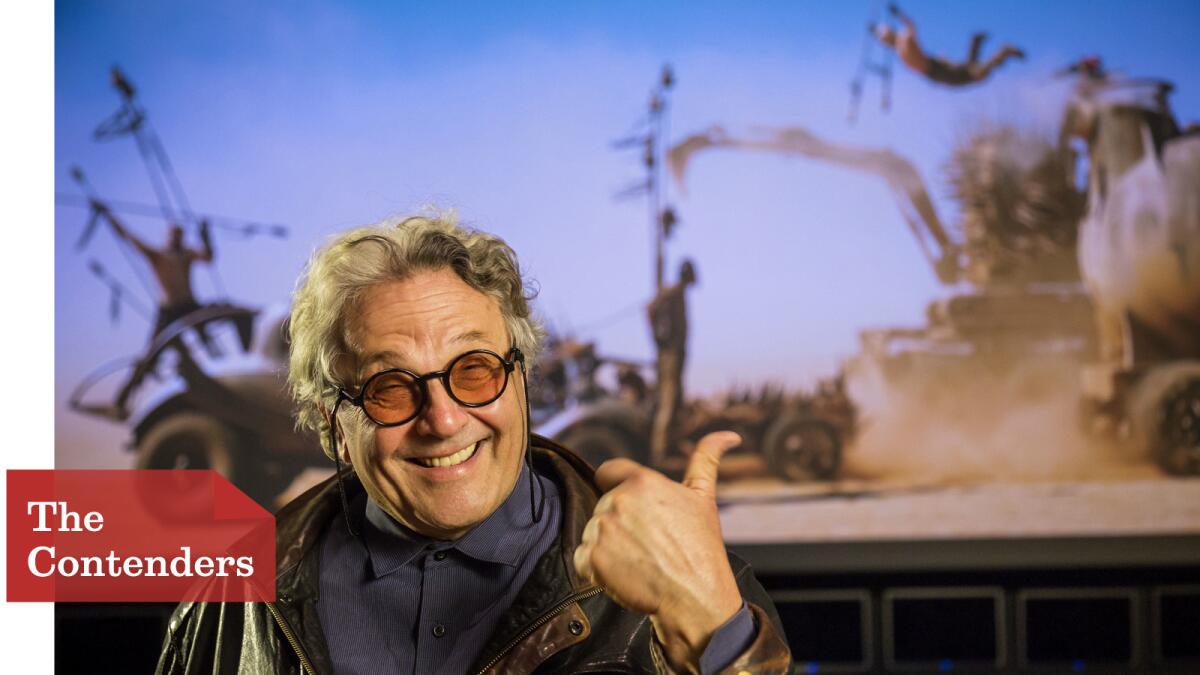The Envelope: Oscars 2016: ‘Mad Max’ director George Miller amazed by fans’ tattoos, love for Doof Warrior

“Mad Max: Fury Road” director George Miller has been surprised by some of the ways the film’s fans have expressed their appreciation.
In the future, 2015 will be recalled as the year of the triumphantly rebooted franchise, of “Star Wars” and “Rocky” springing back to life and, of course, Australian director George Miller’s stark, post-apocalyptic thrill ride, “Mad Max: Fury Road,” which received 10 Oscar nominations, including best picture and director. Miller, 70, spent almost 17 years — filled with unpredictable starts, stops and rebirths — trying to revive the series that stretches back to “Mad Max,” his late-’70s no-budget action flick starring Mel Gibson as Max Rockatansky. Now it’s Tom Hardy in the title role, joined by Charlize Theron as the renegade general Imperator Furiosa, Hugh Keays-Byrne as the wheezing despot Immortan Joe, and make-do war machines rumbling across a desert wasteland.
From a minimal-dialogue script written by Miller, comic-book artist Brendan McCarthy and Nico Lathouris and composed primarily of 3,500 storyboards, “Fury Road” churns with such nonstop invention and virtuosic filmmaking that it led to critical acclaim, grossed $375 million worldwide and, gratifyingly for Miller, passed his “car park” test for audiences. “The best movies are ones that follow you out of the cinema,” said the soft-spoken director recently while sitting in a Warner Bros. soundstage in Burbank. “If I’ve forgotten a movie by the time I’ve gotten to the car park, then it [can’t] be much of a movie.”
What do fans of “Fury Road” — released last May — tell you when they get the opportunity to talk to you?
The thing that gets me is when people show me their tattoos of Immortan Joe, Max, Furiosa, Nux. I was in Japan talking to a critic who was very, very insightful about the movie and he took me into a corner and unbuttoned his shirt. He’d gotten [Immortan Joe’s skull] logo tattooed on his chest. I was so taken aback.
Were you surprised by what moviegoers picked up on?
Definitely pleasing is that the film, which could’ve been read as a simple chase movie, seemed to have so many resonances. The feminist [theme] I knew was there, but I didn’t expect that to be picked up so potently. I didn’t think that the Doof Warrior would be so popular.
You didn’t see a musician in scarlet long johns playing a flame-throwing electric guitar while strapped to a speeding truck as exciting?
I’d no idea. You can’t make a film that’s as rambunctious and wild as this and not have rigorous underpinnings to the story. [The Doof Warrior] is the bugler, the bagpipe player, the music of war that was played before there was recorded or amplified sound. For me, it’s just a logical part of the world.

Much has been ecstatically made of the use of practical stunts over CGI. What piece of new technology proved invaluable?
Do you know about the Edge? It’s a powerful, four-wheel drive vehicle with a crane on top and a camera. It’s got what I call “The Three Headed Beast,” a stunt driver, a crane operator or grip who’s moving the crane and, behind the driver, a camera operator. Then there’s me, the director, sitting in the middle with a screen in front. These guys work so closely together, it’s freakish. We were able to drive in and among these big battles, the camera almost skimming the ground or swooping up into the cabin and into the faces of the actors.
Will we ever see the buzzed-about silent-film version — black and white, no dialogue, just music — of “Fury Road”?
Not in cinemas. The best version of “Road Warrior” was what we called a “slash dupe,” a cheap, black-and-white version of the movie for the composer. Something about it seemed more authentic and elemental. So I asked Eric Whipp, the [“Fury Road”] colorist, “Can I see some scenes in black and white with quite a bit of contrast?” They looked great. So I said to the guys at Warners, “Can we put a black-and-white version on the DVD?” There wasn’t enough room. [It’ll end up] on another version with commentary and other features.
You’ve said your next film will be small, quickly made, and that “Tangerine,” Sean Baker’s indie about transgender sex workers shot entirely on an iPhone 5, inspired you. Explain.
The fact that you can use your iPhone to say something you desperately want to say is wonderful. I loved [“Tangerine”]. It didn’t feel diminished by budget. The method of making it was perfectly matched with its subject. I’ve got two stories — one of them is a bit more technically complex than the other; the other is contemporary. I don’t think it’ll be shot on an iPhone, but it won’t be big, massive cameras.
Do you have any rules for awards season?
Don’t get carried away with expectations. It’s like with doctors: The worst thing you can do is make optimistic prognostications. [laughs] The second thing is to remember that it’s great fun. Be happy that you’re invited to the party. Have the best time you can.
More to Read
From the Oscars to the Emmys.
Get the Envelope newsletter for exclusive awards season coverage, behind-the-scenes stories from the Envelope podcast and columnist Glenn Whipp’s must-read analysis.
You may occasionally receive promotional content from the Los Angeles Times.







